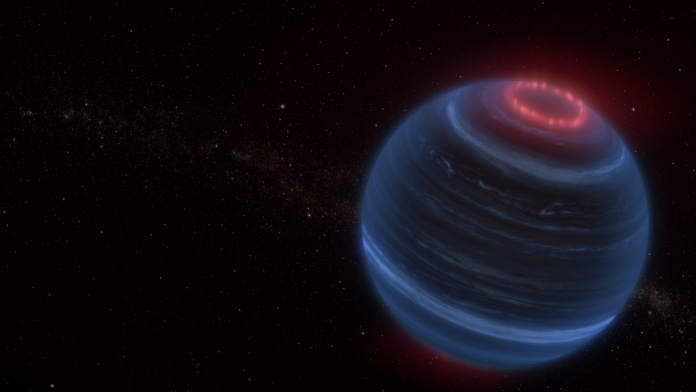
Using the NASA James Webb Space Telescope, astronomers have discovered an enigmatic brown dwarf named W1935, radiating infrared radiation from methane in its upper atmosphere
What are brown dwarfs?
Brown dwarfs, often called “failed stars”, are celestial objects bigger than Jupiter but lacking the necessary mass to sustain nuclear fusion and become stars.
The unexpected nature of this finding lies in the fact that W1935 is a cold, isolated brown dwarf without a host star. There is no obvious external source for the energy responsible for the infrared emission from methane.
One of the leading theories put forward by researchers is that methane emission may be linked to the aurorae- a phenomenon commonly observed in our solar system in gas giants like Jupiter and Saturn.
When are aurorae generated?
Aurorae are displays of light near the poles of the Earth, generated by energetic particles from the Sun interacting with the planet’s magnetic field. However, in the case of W1935, there is no stellar wind present, which is a significant factor in the creation of aurora in our solar system. This leaves astronomers puzzled about the source of the brown dwarf’s glowing atmosphere.
Using the Webb telescope, the team investigated a dozen cold brown dwarfs. W1935, discovered by scientist Dan Caselden through the Backyard Worlds Zooniverse project, stood out due to its methane emission, a rare feature among brown dwarfs.
W2220 was also discovered by NASA’s Wide Field Infrared Survey Explorer and appeared to be very similar to W1935 in terms of the composition, brightness, temperature and spectral features, except for the absence of methane emission.
Faherty expressed her surprise, stating, “We expected to see methane because methane is all over these brown dwarfs. But instead of absorbing light, we saw just the opposite: The methane was glowing. My first thought was, what the heck? Why is methane emission coming out of this object?”
Cosmic mystery
The team employed computer models to unravel this cosmic mystery, revealing that W1935 exhibited a temperature inversion in its atmosphere, getting warmer with increasing altitude.
This phenomenon, common in planets like Jupiter and Saturn, perplexes an object with no discernible external heat source. Ben Burningham, the lead modeller on the project from the University of Hertfordshire, noted, “This temperature inversion is really puzzling. We have seen this kind of phenomenon in planets with a nearby star that can heat the stratosphere, but seeing it in an object with no obvious external heat source is wild.”
Drawing parallels with our solar system
Where aurorae are associated with gas giant planets, the team speculates that W1935’s methane emission might be linked to a similar process involving interactions with interstellar plasma or a hypothetical nearby active moon.
This is not the first time aurorae have been gathered to explain brown dwarf observations, but W1935 is unique as the first auroral candidate outside our solar system exhibiting methane emission.
It is also the coldest auroral candidate discovered beyond our solar system, with a temperature of about 400 degrees Fahrenheit (200 degrees Celsius), approximately 600 degrees Fahrenheit warmer than Jupiter.
The absence of a companion star or stellar wind to contribute to the auroral process adds a layer of complexity to understanding W1935’s atmospheric phenomena.
A spectacular extension of a solar system phenomenon without any stellar irradiation to help in the explanation
“With W1935, we now have a spectacular extension of a solar system phenomenon without any stellar irradiation to help in the explanation,” Faherty noted. “With Webb, we can really ‘open the hood’ on the chemistry and unpack how similar or different the auroral process may be beyond our solar system,” she added.










